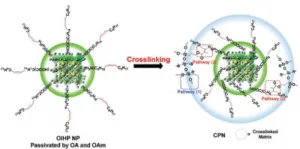A research team led by Professors Byung Soo Bae at the Wearable Platform Materials Technology Center within the Korea Advanced Institute of Science and Technology (Daejeon, Korea) and Taewoo Lee at Seoul National University (Seoul, Korea) has developed a new organic-inorganic hybrid perovskite light emitting diode display material. The new material claims to minimize the degradation found in conventional perovskite materials when exposed to light, heat, moisture and oxygen while, at the same time, keeping the material structure and manufacturing process simple.

In addressing these issues, the team adopted an approach based on a heat resistant substance called siloxane. Relatively small particles of siloxane were chemically reacted with perovskite nanoparticles in such a way as to encapsulate and protect the nanoparticles.
A recent article on this topic by the team is entitled “Extremely Stable Luminescent Crosslinked Perovskite Nanoparticles under Harsh Environments over 1.5 Years.” The article was published in Adv. Mater. 2020, 2005255. A copy of the article is available for purchase and can be found here.
The technical article provides a great deal of information on the materials, fabrication processes and testing of the new material. Also contained within the article are the details of demonstration green and white emitting flexible large area displays.
Here are a few top level comments paraphrased from the article.
Unsaturated hydrocarbons in both the acid and base ligands of nanoparticles are chemically crosslinked with a methacrylate-functionalized matrix. This is illustrated in the figure below.
Schematic illustration of crosslinked perovskite nanoparticle (CPN) formation. Left: crosslinking among C=C bonds in methacrylate group. Right: crosslinking between C=C bond of the methacrylate group in the matrix and the C=C bonds of the organic ligands (oleic acid OA or oleylamine OAm) on the OIHP NPs (organic-inorganic hybrid perovskites nanoparticles)
This encapsulation serves to prevent decomposition of the perovskite crystals Counterintuitively, water vapor permeating through the crosslinked matrix chemically passivates surface defects in the nanoparticles and reduces non-radiative recombination. By this means it was found possible to maintain existing luminescence performance while preventing moisture and oxygen penetration at the molecular level.
More specifically, the team reports that the performance of test samples of crosslinked perovskite nanoparticles was measured over the course of more than 100 days under conditions of high temperature (85 °C) and high relative humidity (85%). The research team confirmed that the photoluminescence quantum yield / luminous efficiency remained above the original 70%. In fact, this maintenance period was calculated to be 600 days or longer without additional encapsulation.
As an added benefit, the researchers noted that “The siloxane capsule can also prevent the toxicity of lead, a component of perovskite.”
The team concludes their article with the following two thoughts: First, since the new materials use existing means of synthesis, the process is cost effective. Second, that the new materials provide an opportunity to accelerate the commercialization of the next generation of light emitting materials for display applications. – Arthur Berman
Seoul National University, Taewoo Lee, [email protected]
Korea Advanced Institute of Science and Technology, Byung Soo Bae, [email protected]

